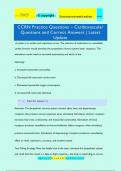2024 /2025 | © copyright | This work may not be copied for profit gain Excel!
CCRN Practice Questions – Cardiovascular
Questions and Correct Answers | Latest
Update
A patient is in cardiac and respiratory arrest. The selection of medications to reestablish
cardiac function would stimulate the sympathetic nervous system beta1 receptors. This
stimulation would result in increased automaticity and which of the
following?
a. Increased myocardial contractility
b. Decreased left ventricular stroke work
c. Decreased myocardial oxygen consumption
d. Increased left ventricular afterload
✓ -:- Correct answer: a
Rationale: The sympathetic nervous system contains alpha, beta, and dopaminergic
receptors that produce various responses when stimulated. Stimulation of beta1 receptors
increases heart rate, conductivity, and myocardial contractility. Stimulation of beta2
receptors produces vasodilation and bronchodilation. Alpha receptors, when stimulated,
produce vasoconstriction. Stimulation of dopaminergic receptors produces a vasodilating
effect on renal, mesenteric, coronary, and cerebral vessels.
Test-Taking Strategy: Note the helpful clue in the stem: stimulate the sympathetic system
and recall that this results in a fight-or-flight response—the body is responding to survive.
1|P a g e | G r a d e A + | 2 0 2 0 2 5
,2024 /2025 | © copyright | This work may not be copied for profit gain Excel!
Stroke volume would increase, so eliminate option b. Afterload would increase, but this is
due to alpha stimulation, not beta1 stimulation, so eliminate option d. Because the heart is
working faster and harder, the myocardial oxygen consumption does increase, so eliminate
option c. Remember that the primary effects of beta1 receptors are to increase heart rate,
contractility, and rate of conduction. Choose option a. A memory aid that also may help is
this: beta 1 beta 2, 1 heart 2 lungs: beta1 affects the heart, and beta2 affects the lungs.
A patient arrived in the emergency department with complaints of chest pain. The 12-lead
electrocardiogram shows ST segment elevation in leads V3 and V4. Occlusion of the
affected coronary artery most likely would affect perfusion to which portion of the
conduction system?
a. Sinoatrial (SA) node
b. Bachmann's bundle
c. Atrioventricular (AV) node
d. Bundle of His
✓ -:- Correct answer: d
Rationale: ST segment elevation in leads V3 and V4 indicates injury to the anterior wall,
which would occur with occlusion of the left anterior descending (LAD) artery. In most
persons, the SA node, Bachmann's bundle, and AV node are supplied by the right coronary
artery. The bundle of His is supplied by the left anterior descending artery. This is why an
2|P a g e | G r a d e A + | 2 0 2 0 2 5
,2024 /2025 | © copyright | This work may not be copied for profit gain Excel!
anterior myocardial infarction may cause type II second-degree AV block or third-degree
AV heart block at the level of the bundle of His.
Test-Taking Strategy: Note that options a, b, and c are part of the supraventricular
conduction system. They usually are supplied by the right coronary artery. The LAD artery
supplies most of the interventricular conduction system, including the bundle of His and
the bundle branches.
Oxygen delivery (DO2) is the product of which of the following?
a. PaO2, hemoglobin, mean arterial pressure
b. SaO2, hemoglobin, cardiac output
c. SvO2, cardiac index, SaO2
d. PaO2, mean arterial pressure, SvO2
✓ -:- Correct answer: b
Rationale: Ninety-seven percent of oxygen is attached to the hemoglobin molecule, so the
SaO2 (arterial oxygen saturation) is a more accurate reflection of the amount of oxygen in
blood. The PaO2 represents only the 3% that is dissolved in the plasma. The lungs must put
the oxygen in the blood, the hemoglobin must carry the oxygen, and the cardiac output is a
reflection of how well the heart is moving the blood with its hemoglobin with attached
oxygen. SvO2 (venous oxygen saturation) is a reflection of the oxygen reserve. SvO2 is
what is left over after the tissues have extracted what they need. The mean arterial
3|P a g e | G r a d e A + | 2 0 2 0 2 5
, 2024 /2025 | © copyright | This work may not be copied for profit gain Excel!
pressure is a reflection of organ tissue perfusion pressure but does not indicate anything
about the amount of oxygen in that blood.
Test-Taking Strategy: Oxygen is delivered from the arterial end, so choose an option that
has SaO2 instead of SvO2. Also remember that most oxygen is carried on hemoglobin.
Look for SaO2 (not PaO2) and hemoglobin. The only option with both of these is option b.
Which of the following types of block are most likely after an anterior wall myocardial
infarction (MI)?
a. Sinus block
b. Second-degree atrioventricular (AV) block, type I
c. Second-degree AV block, type II
d. Third-degree AV block with junctional escape rhythm
✓ -:- Correct answer: c
Rationale: Anterior MI is caused by a left anterior descending (LAD) artery lesion. The LAD
artery supplies the bundle of His and bundle branches, so anterior MIs may cause blocks of
the bundle of His or bundle branches. Second-degree AV block type II is a block at the level
of the bundle of His. If this patient does develop a third-degree AV block, it would be at the
level of the bundle of His, and the only escape rhythm available below the bundle of His is a
ventricular escape rhythm.
4|P a g e | G r a d e A + | 2 0 2 0 2 5




